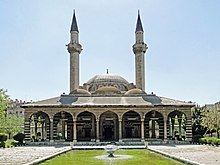Takya
A takya
In the Ottoman Empire, many takyas or tekyes/tekkes were built, most notably for use by the Mevlevi Order and the Bektashi Order[7] .
In
).In
In the modern
Etymology
The
Other words were derived from تَکْیه takya in Classical Persian, such as تکیهنشین takya-nishīn and تکیهدار takya-dār both meaning a Sufi.
Ottoman Empire

Many takyas (or tekkeler in

By the 20th century, Istanbul itself counted many takyas. Some were dedicated to certain Muslim communities (for example, the Uzbeks' Takya[d] or the Indians' Takya[e]) which symbolized a certain recognition of these communities by the Ottomans.[22] Iranians in Istanbul in the 1870s also attempted to establish a "Takya Ḥosayniya"[23] (Turkish: Hüseyniye Tekkesi),[23] which was meant to be used as a husayniyya like the takyas of Iran .

Ottoman takyas can be found in Albania, in Bosnia and Herzegovina, in Cyprus, in Egypt, in Greece, in North Macedonia and in Syria.
South Asia

In
In
Iran

Following the
Azerbaijan
In Azerbaijan, examples of takyas (or təkyələr in Azerbaijani) include the Takya in the Old City of Baku.
Modern Arab world
In the modern
Notes
References
- ^ a b Steingass, Francis Joseph (1892). A Comprehensive Persian-English Dictionary, including the Arabic words and phrases to be met with in Persian literature. London: Routledge & K. Paul. p. 319.
- ^ Hayyim, Sulayman (1934). "تکیه". New Persian-English Dictionary. Vol. 1. Teheran: Librairie-imprimerie Béroukhim. p. 469.
- ^ "təkyə". Azərbaycan dilinin izahlı lüğəti (in Azerbaijani).
- ^ a b Redhouse, James W. (1890). "تكیه". A Turkish and English Lexicon. Constantinople: A. H. Boyajian. p. 585.
- ^ a b c d Salah-ud-Din, Iqbal (2002). "تکیہ". Vaḍḍī Panjābī lughat: Panjābī tūn Panjābī. Lāhaur: ʻAzīz Pablisharz. p. 790.
- ^ Platts, John T. (1884). A Dictionary of Urdu, Classical Hindi and English. London: W. H. Allen & Co. p. 332.
- ^ TDV Encyclopedia of Islam (44+2 vols.) (in Turkish). Istanbul: Turkiye Diyanet Foundation, Centre for Islamic Studies. 1988–2016.
- ^ a b Rahman, Abdur (1984). Science and Technology in Indian Culture: A Historical Perspective.
Shah Musafir, whose 'takia' is at Aurangabad
- ^ ISBN 978-1-78969-745-2.
Musafir (takya de 1739)
- ^ a b The Book Review. 2001. p. 8.
The younger shaykh, Baba Musafir, turned to the task of establishing a takya or khanqah at Awrangabad
- ^ ISBN 978-1-000-89880-4.
takya at Aurangabad
- ^ JSTOR 4299981.
the Takya of Bābā Musāfir in Awrangābād
- ^ سب رس (in Urdu). 2007.
- ^ a b A. D. Khan (1994). Diplomatics of the Soyurghal Farman of the Great Mughals. p. 6.
takyas (graveyards)
- ^ a b Uttar Pradesh District Gazetteers. 1979. p. 33.
- ^ a b Sharif, Ja'far; Crooke, William (2017). Islam in India.
Takya, a pillow, a resting-place of Faqīrs
- ^ a b محمد صادق محمد الكرباسي (2019). معجم المشاريع الحسينيّة - الجزء الثالث: دائرة المعارف الحسينية (in Arabic).
بناء الحسينية كان حديث العهد بإيران، وأما التكايا فكانت معروفة ومنتشرة في أنحاء إيران وكانت تقام فيها بعض الشعائر الحسينية أيضا قبل أن تنتقل إلى الحسينيات التي تخصصت بالشعائر الحسينية.
- ^ Parmanand, Mewaram (1910). "تَڪْيو". Sindhi-English Dictionary. Hyderabad, Sindh: The Sind Juvenile Co-operative Society. p. 96.
- TDV Encyclopedia of Islam (44+2 vols.) (in Turkish). Istanbul: Turkiye Diyanet Foundation, Centre for Islamic Studies. 1988–2016.
Osmanlılar'da hankah yerine daha çok dergâh, tekke ve zâviye kelimeleri kullanılmıştır
- ^ ايغناتس قونوس. تورك خلق ادبياتی (in Ottoman Turkish). p. 38.
- ^ Ahmet Cevdet Paşa (1893). تاريخ جودت (in Ottoman Turkish). p. 70.
- ^ M. Naeem Qureshi (1999). Pan-Islam in British Indian Politics: A Study of the Khilafat Movement, 1918-1924. p. 16.
- ^ hdl:11424/254280.
- ^ Ridgeon, Lloyd (2020). Routledge Handbook on Sufism.
takya is used also in India and in Xinjiang (China). In the Indian subcontinent, the terms used are jamā'at-khāna (meeting room), takya (pillow, bolster) or dargāh (royal court) and langar (refectory), a term of Sanskrit origin, and sometimes imarat (religious complex).
- ^ العمارة الاسلامية بإيران مساجد - مدارس - حسينيات (in Arabic). p. 391.
- ^ Encyclopedia of Islam. 2009. p. 320.
- ^ Zulfikar Hirji (2010). Diversity and Pluralism in Islam.
- aljazeera.net(in Arabic). 2018-05-25.


